Frost Protection
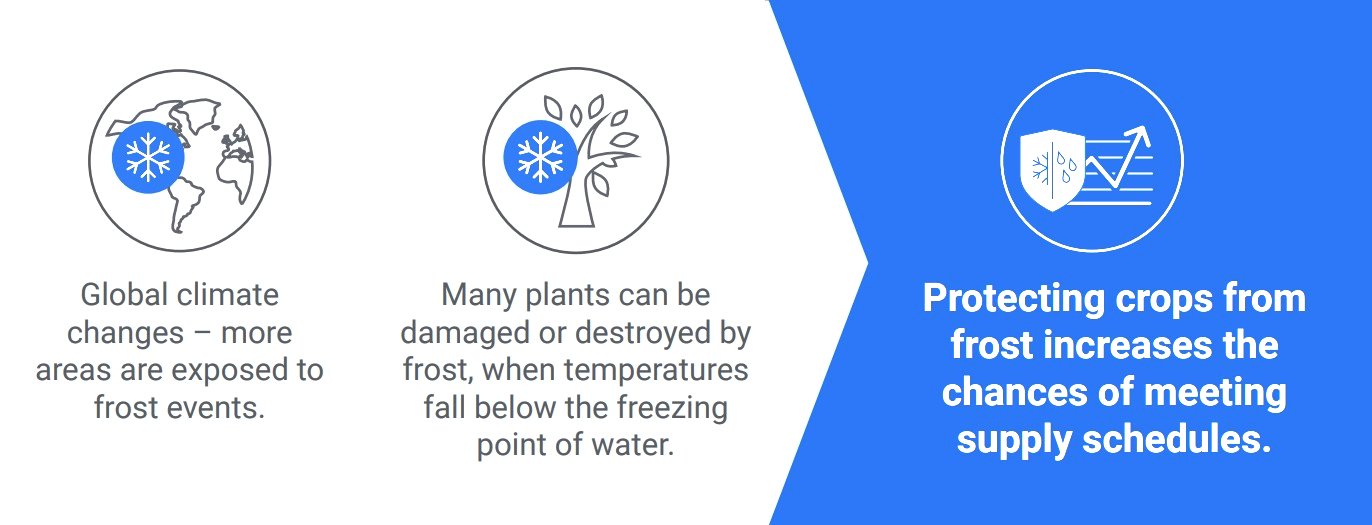
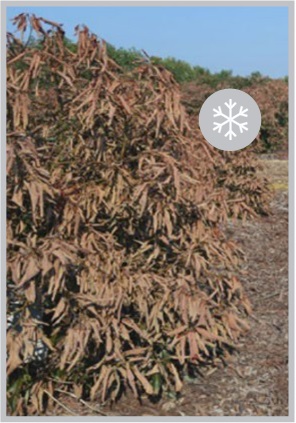
Frost damaged Avocados -
What is Frost?
Frost (n.) is the coating of ice that may form, in humid air, in cold conditions.
Resulting from decreased temperatures on a solid surface, the water-vapor contained in the saturated air, freezes on the surface.
- Many plants can be affected or destroyed by temperatures below the freezing point of water, and frost.
- This will vary according to the type of plant tissue or organism exposed to low temperatures.
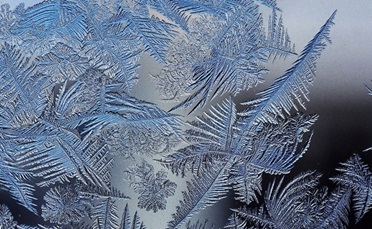
Frost Types
Advection frost:
Advection frost is a type of frost that occurs when a cold wind blows over a surface, such as the ground or vegetation, causing the temperature of that surface to drop below freezing point. This happens because the wind carries away the warmer air that was in contact with the surface, allowing the colder air to come into direct contact with it. As a result, moisture in the air may condense and freeze on the surface, forming a layer of frost.
Advection frost can have significant impacts on agriculture, as it can damage or kill crops and plants.
![]() There is no known solution for this.
There is no known solution for this.
Spring Radiation Frost:
Radiation frost is a type of frost that forms on clear, calm nights when the Earth's surface loses heat through radiation to the clear sky. This type of frost occurs when the ground and other surfaces cool down quickly after sunset, and the surrounding air becomes cold enough for the moisture in the air to freeze.
- This is the weather event that causes the greatest damage to fruit trees.
- In this case, frost mitigation is indispensable in certain geographical areas to ensure regular harvest operation in terms of timing/delay, quantity and quality.
Damage to the Plant During Frost Conditions
Physical processes during spring frost:
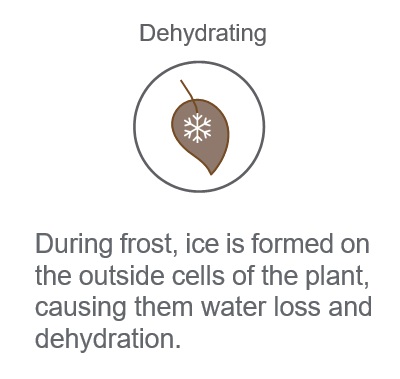
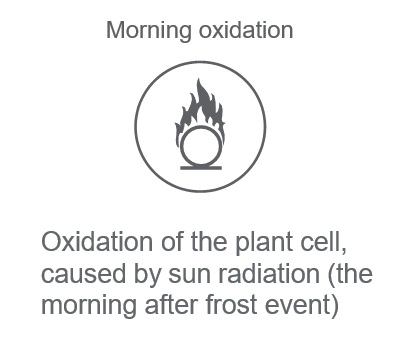
Damage to the plant during frost conditions
Types of crops that typically suffer from frost damage:
-
Apples
-
Pears
-
Kiwifruit
-
Avocado
-
Vineyard
-
Berries
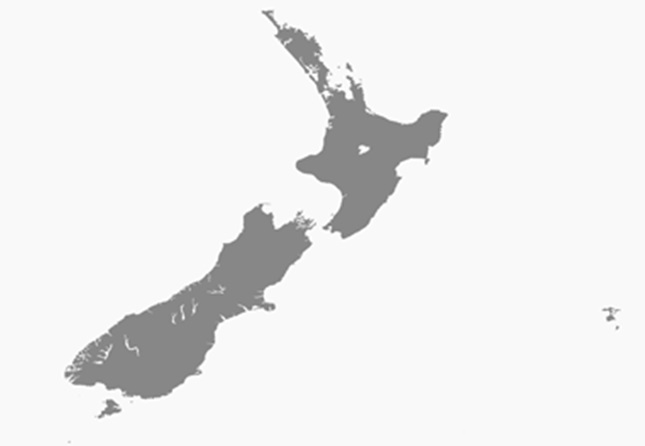
Practices to Protect Against Frost
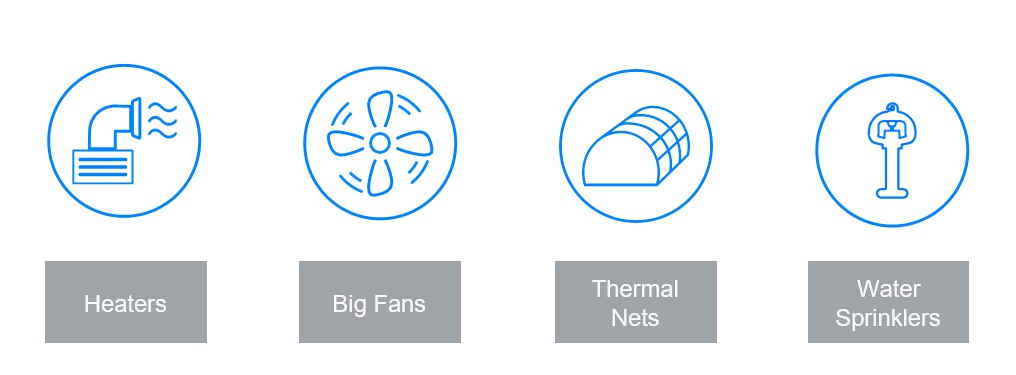
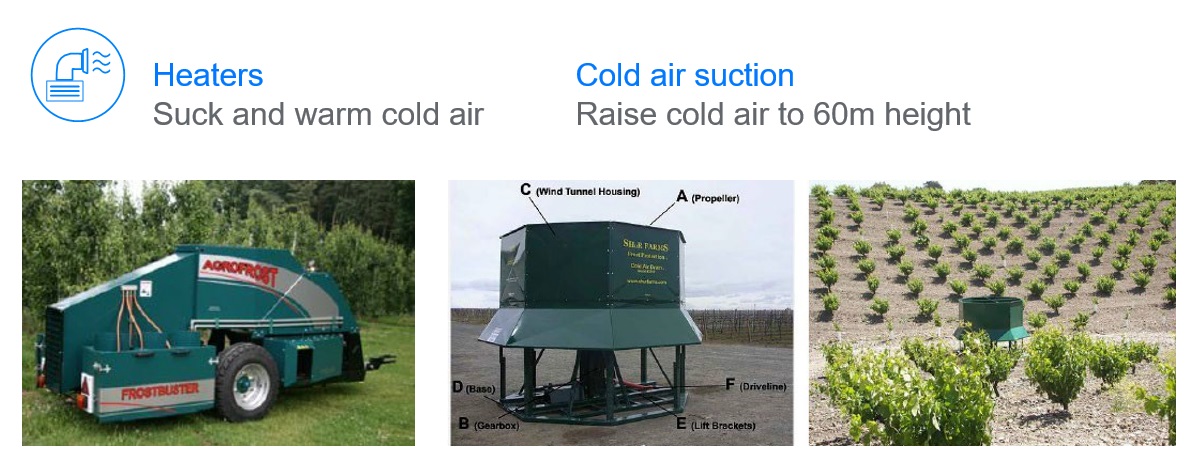
Cold air heaters, also known as frost protection fans, are used by farmers and growers to protect crops from frost damage. These heaters work by circulating the air around the plants, creating a layer of warm air that can help to prevent frost from settling on the plants.
The heaters work by drawing in cold air from the surrounding area and passing it through a heating element, which warms the air before it is blown back out into the field. The warm air rises and mixes with the colder air above, creating a layer of warm air around the plants. This layer of warm air can help to prevent frost from forming on the plants, as the warm air helps to keep the temperature above freezing.
It is important to note that while cold air heaters can be effective at preventing frost damage, they can be expensive to operate and may not be practical for all crops or growing conditions.
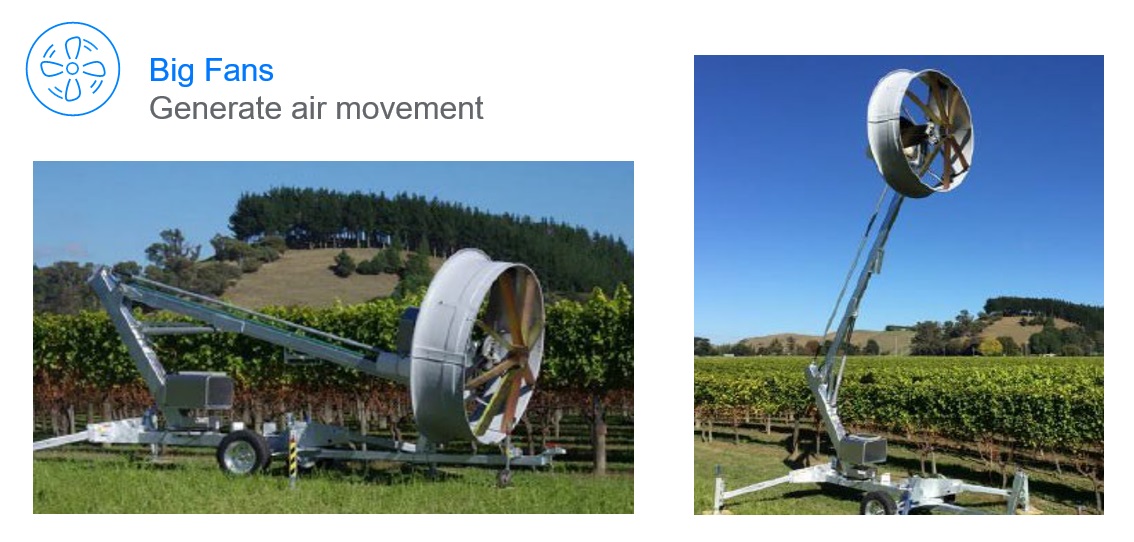
Big fans, also known as wind machines or frost protection fans, are another type of equipment used for frost protection in agriculture. These fans work by creating a layer of turbulent air around the crops, which can help to mix warmer air from higher in the atmosphere with the cooler air near the ground, preventing frost from forming on the plants.
The fans are typically large and powerful, with blades that can span up to 20 feet or more. They are often mounted on tall poles or towers, and are positioned around the perimeter of the crop, blowing air inwards. The fans can be operated manually or automatically, depending on the temperature and weather conditions.
To use big fans for frost protection, the fans are typically turned on before the temperature drops below freezing, when the colder air is still mixing with warmer air higher in the atmosphere. The fans can be run continuously throughout the night, or turned on and off as needed depending on the temperature and weather conditions.
Big fans can be effective at preventing frost damage, especially in areas where radiation frost is common. However, they can be expensive to operate and may not be practical for all crops or growing conditions.
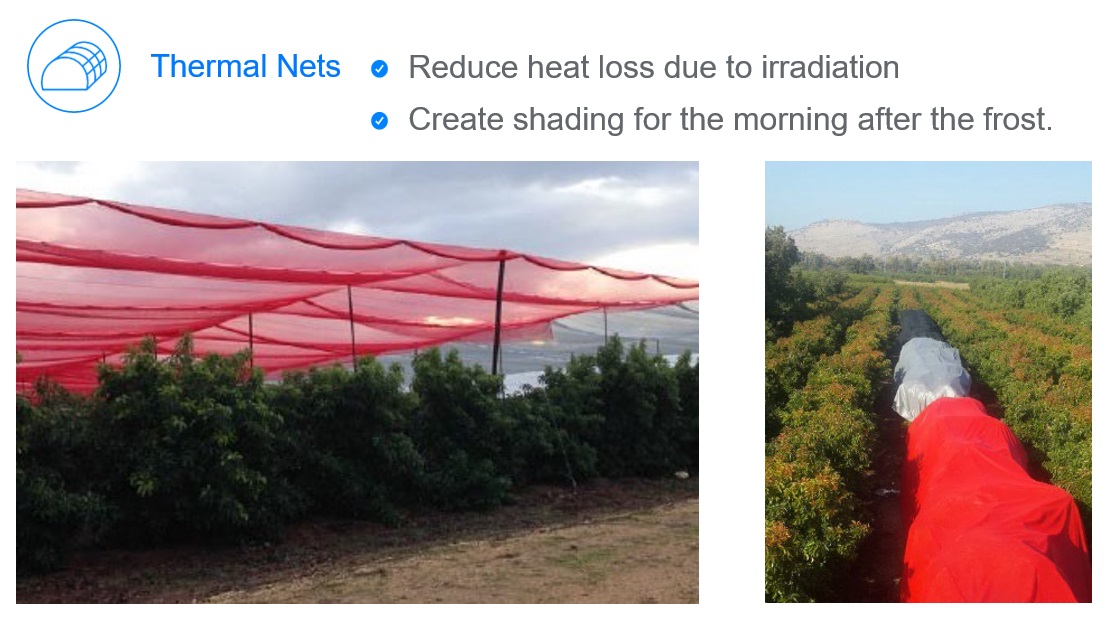
Thermal nets, also known as frost blankets or crop covers, are another type of equipment used for frost protection in agriculture. These nets are made from a breathable material that allows light and water to pass through, while also providing a layer of insulation to protect crops from frost damage.
Thermal nets work by trapping a layer of warm air around the plants, which can help to prevent frost from settling on them. The nets are typically laid over the plants, either manually or with the use of specialized equipment, and are secured in place using weights or stakes. They can be used on a variety of crops, including fruit trees, vegetables, and ornamental plants.
They are relatively inexpensive and easy to use, and can be deployed quickly when needed. However, they may not be practical for all crops or growing conditions, as they can be heavy and may require specialized equipment for deployment.
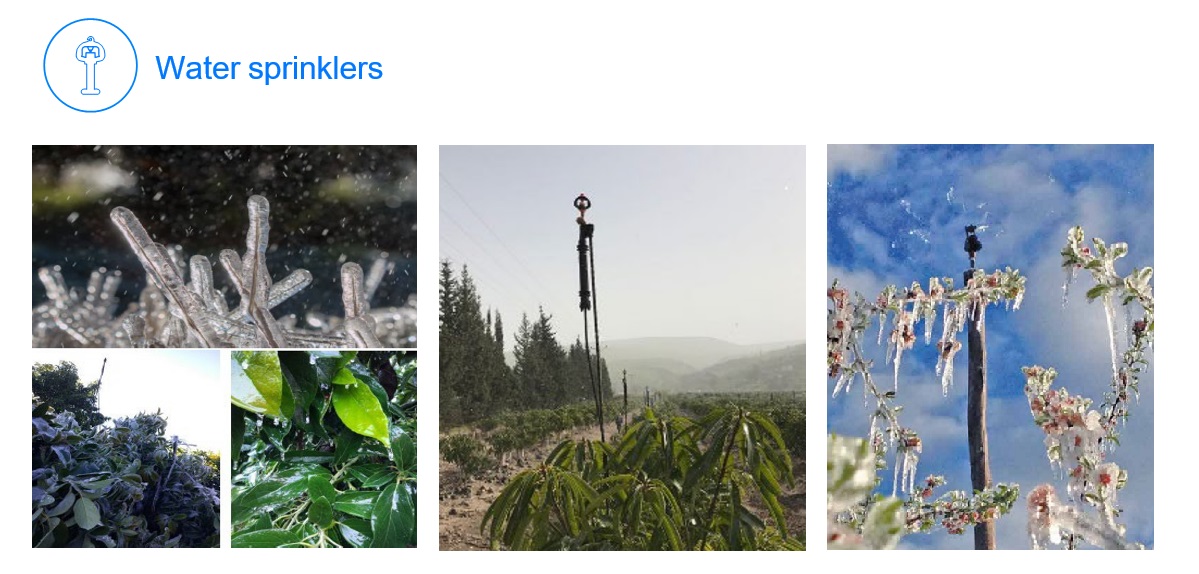
Water sprinklers can be an effective method of frost protection for crops and plants. When water is sprayed onto plants during freezing temperatures, the water droplets form a thin layer of ice on the plants' surface, which can insulate them from the freezing air.
This process works because as water freezes, it releases heat. This heat helps to keep the plants and their immediate surroundings from dropping below the freezing point. The layer of ice that forms on the plants can also act as a barrier, preventing further heat loss from the plants.
Frost Protection Methods Comparison
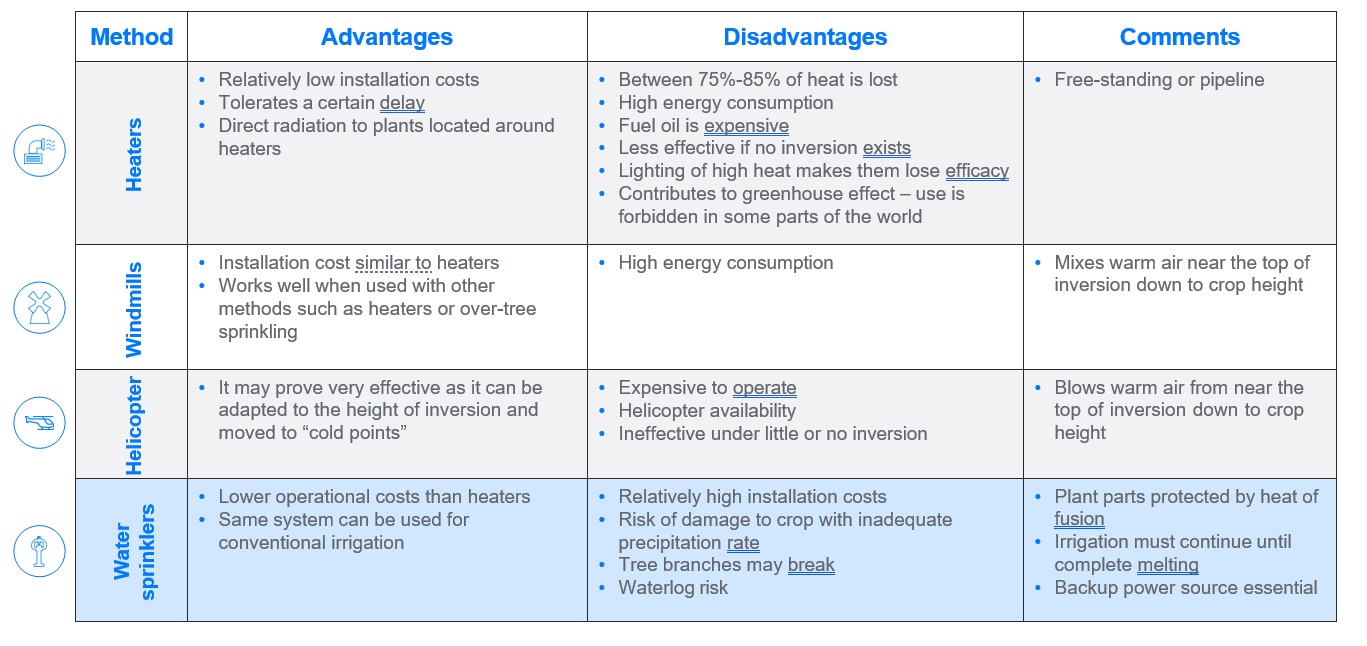
Main Advantages of Frost Protection by Water
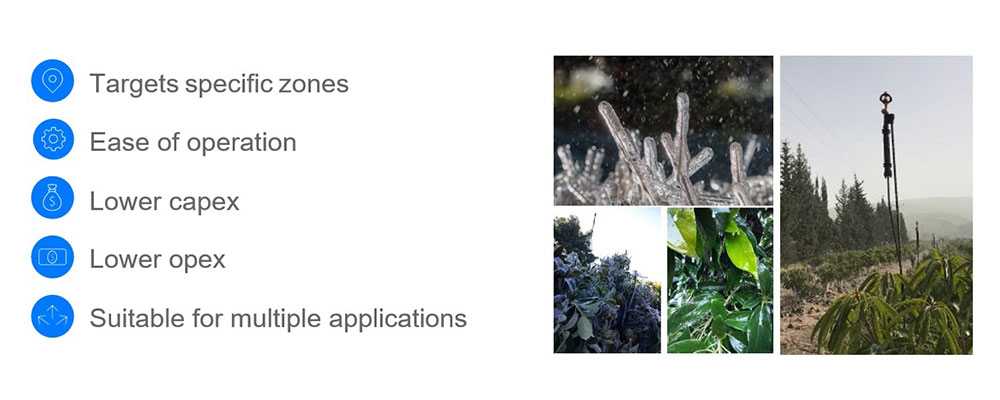
How Overhead Sprinklers Can Mitigate the Frost Damage?
Three physical processes occur:

- Energy is transferred to the air. Water temperature is higher than air temperature. As water cools down, it transfers energy to the surrounding air and warms it
- Energy is transferred to the plant itself. Water temperature is higher than plant temperature, with the sprayed water creating a temperature gradient between the water and plant. This makes the energy from the increased water temperature move to the decreased plant temperature

- Latent heat, is heat that is either absorbed or given off during material phase change.
- Water is spread and turns into ice, e.g. change its phase from liquid to solid. During this phase change, 80 calories per gram of water is given off with no change in the temperature of water.

- A mixture of ice and water exposed to a temperature below the freezing point will remain at 0°C until all water is frozen.
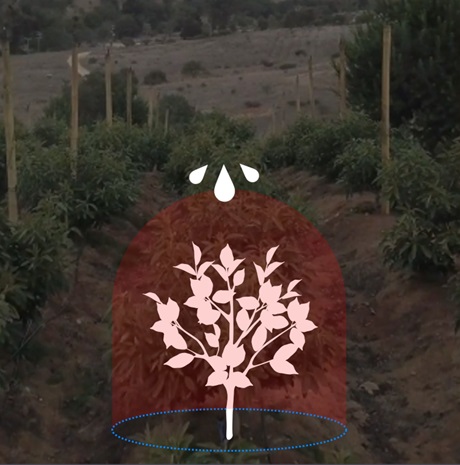
The Importance of Temperature Measurements
To effectively choose and manage a frost protection system for crops, it is crucial for growers to keep track of the temperatures within the vineyard during frost events. Data loggers, which are affordable and easy to use, allow for the compilation and storage of temperature records throughout the orchard. Historical records can be used to develop frost profiles, which are useful for managing a frost protection system, and to gather information on prevailing conditions in the event of system failure.
When measuring crop temperature, accuracy is key. While sensor accuracy is important, placement and shielding are equally critical. A sensor located in a radiation shield provides an air temperature reading but is not a reliable indicator of damage or when to initiate frost protection. A sensor exposed to the sky is recommended instead, as it provides a temperature reading closer to that of a bud or shoot.
Multiple temperature sensors are typically used on an orchard and are connected to wireless remotes to cover frost-prone areas of the property. If any of these sensors drop below the frost alarm thresholds, alarms and updates will be triggered. Frequent updates on frost conditions are particularly helpful in determining the effectiveness of frost fighting efforts.
If one of the temperature sensors is a combined temperature/humidity sensor, the wet bulb temperature can be calculated. This is useful for growers who use water for frost protection, as the wet bulb temperature indicates the temperature to which the air will drop as soon as the plants are wetted. The air temperature often drops 2-3°C when the frost protection water is first turned on, which can cause crop damage. For this reason, frost protection water should be set to turn on based on the wet bulb temperature.

Radiation shield and exposed sensor
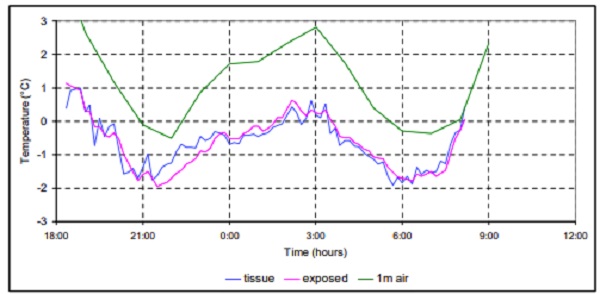
Example of 5mm exposed temperature sensor and tissue temperature
Important Factors to Consider While Choosing a Frost Protection System
![]() Distance between trees and diameter of the trees
Distance between trees and diameter of the trees
![]() Tree top diameter during frost season
Tree top diameter during frost season
![]() Size of protected area
Size of protected area
![]() Water availability
Water availability
![]() Energy availability
Energy availability
![]() Site topography & its particular microclimate spots
Site topography & its particular microclimate spots
![]() Meteorological properties of the site
Meteorological properties of the site
![]() Expected duration of a typical frost event
Expected duration of a typical frost event

Common Frost Protection Sprinklers
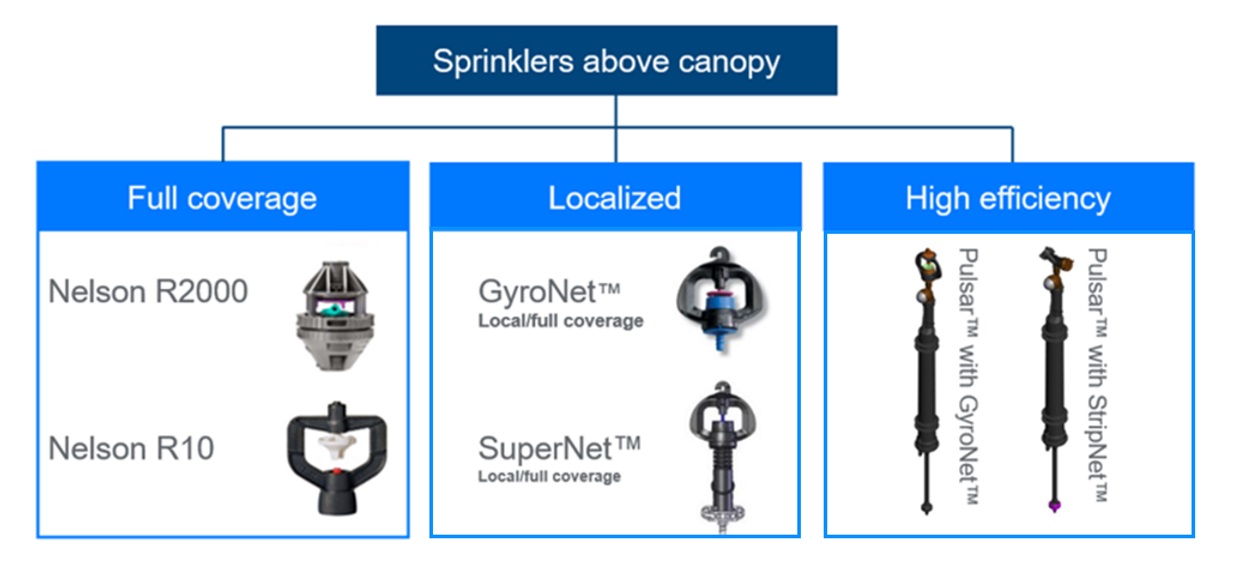
Application Rate Required
Quantity of Water Per Area
Units used:
![]() Precipitation – mm/hr. (1mm = 1 litre/m2)
Precipitation – mm/hr. (1mm = 1 litre/m2)
![]() Area – m2
Area – m2
![]() Quantity of water – m3/hr. (1,000 litres = 1m3)
Quantity of water – m3/hr. (1,000 litres = 1m3)
Example:
![]() Precipitation = 3.5 mm/hr.
Precipitation = 3.5 mm/hr.
![]() Area = 1 Ha. = 10,000 m2
Area = 1 Ha. = 10,000 m2
![]() Quantity of water in case the entire area is covered :
Quantity of water in case the entire area is covered :
3.5mm x 10,000 m2 = 35 m3/hr. (35,000 litres) for 1 ha.
Distribution from a Single Sprinkler
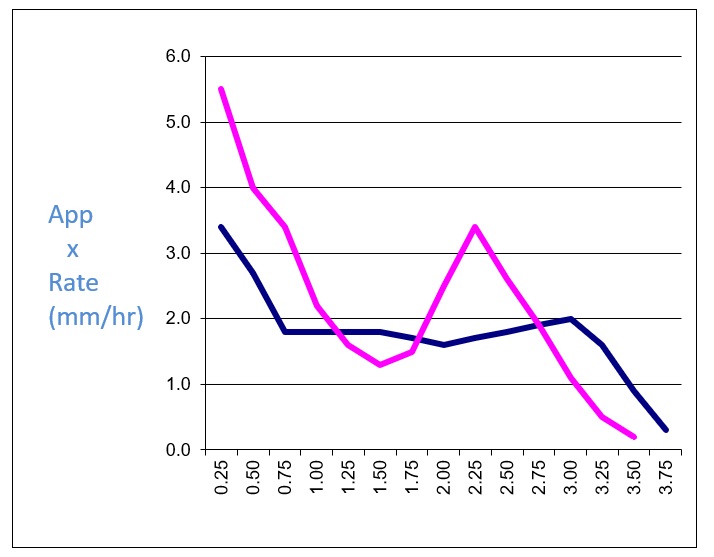

The Importance of Uniformity/Distribution
Computer-generated distribution uniformities provide a comprehensive analysis of the water distribution across the entire orchard, taking into account factors such as potential frost temperature, frost drainage, post and row spacing, crop coverage, and crop type. This information can then be used to determine the most suitable sprinkler type and the correct sprinkler spacing for the orchard, ensuring optimal water coverage and uniformity. By utilizing computer-generated distribution uniformities, growers can be assured that the system will operate with an even application over the property allowing effective management of the system.
Sprinkler Uniformity
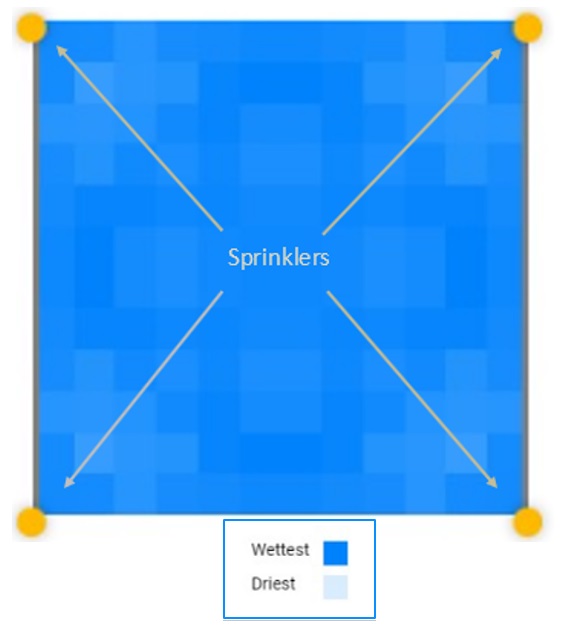
Data from NetSpeX Program showing sprinkler coverage and overlap pattern
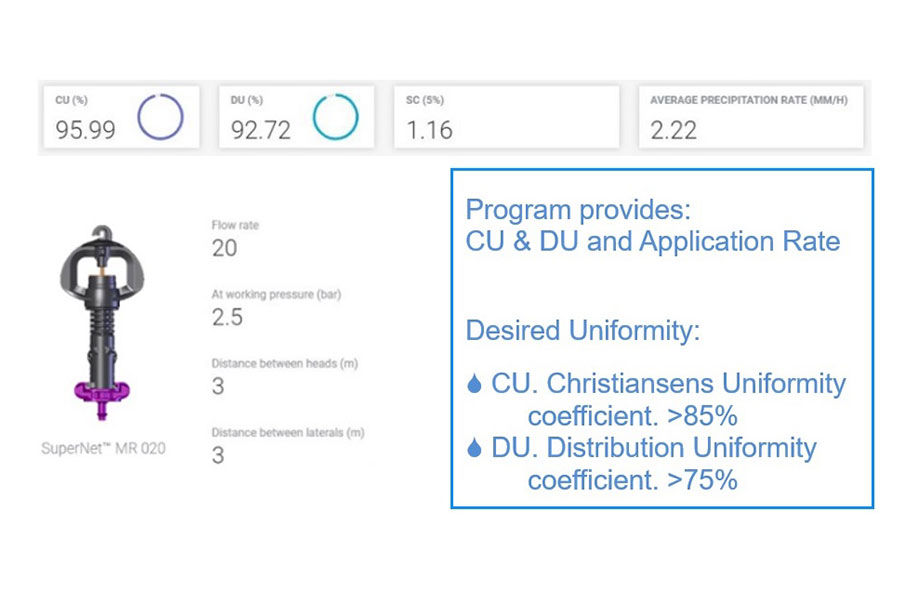
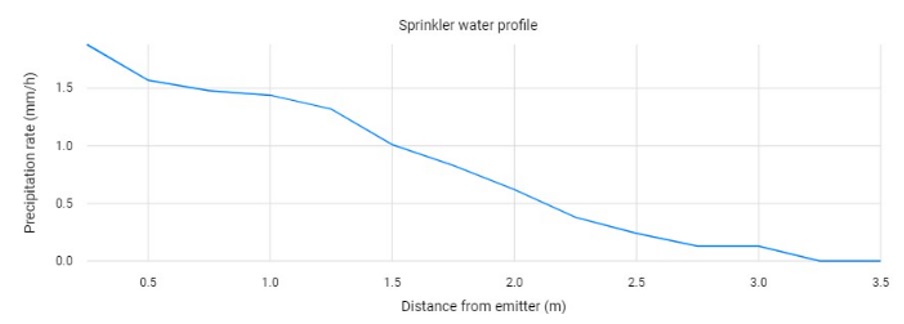
Poor Uniformity on Grapes
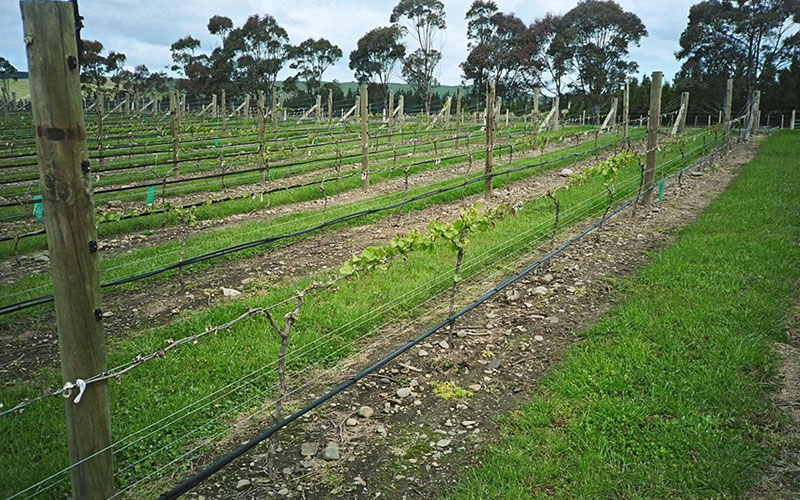
Dos and Donts
→Complete system installation before the frost season begins.
→Check the system shortly before an expected frost event.
→Don’t delegate frost mitigation to someone else
→Be prepared. Every second counts
→Open the system ON-TIME (2.5°C)
→Ensure water is applied continuously.
→Monitor temperatures and system through the frost. If you are using a pulsed system you may need to adjust this to suit the temperature.
→Don’t shut down the system too early. The sun is up, freezing has stopped and ice is falling off. Beware of sudden tips in temperature after sunrise.
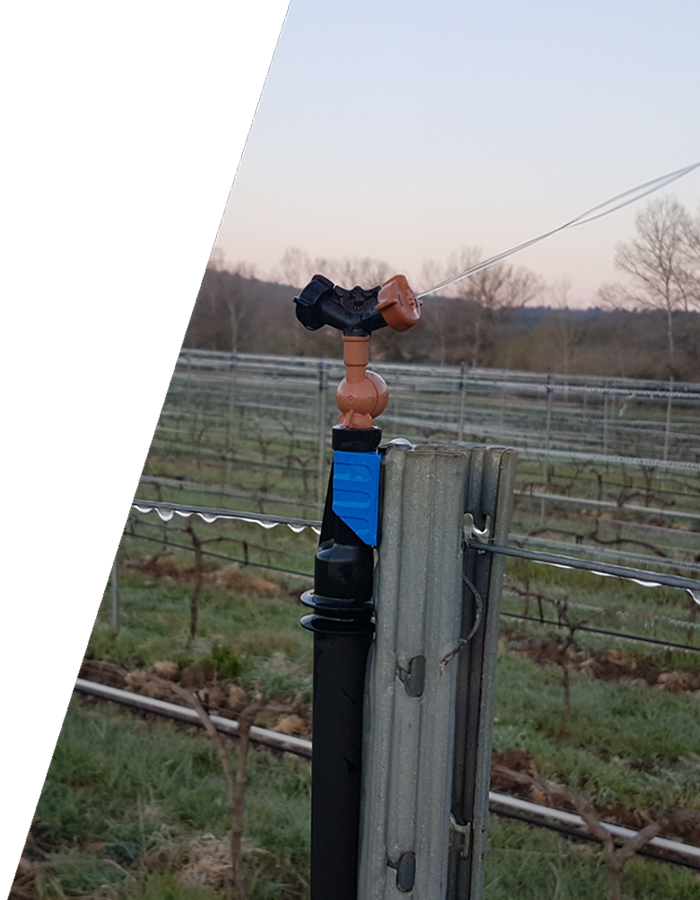
Frost Protection Design
If you need assistance in designing or planning Frost Protection for your crops, you can send us your details at:
support@irrigationexpress.co.nz
Or give us a call at:
(+64) 07 575 6362
0800 130 905
Click the following Link to see the requirements we need from you to start with your Frost Protection Design:
